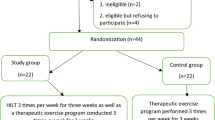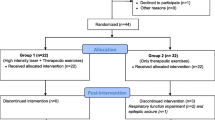Abstract
Objective
To investigate the community promotion feasibility of superficial needling plus club swing for post-stroke motion impairment of the shoulder joint.
Methods
A total of 180 cases (duration <1.5 years) with post-stroke motion impairment of the shoulder joint were recruited from three community health centers in Changning District, 60 from each community. They were randomly allocated into an observation group (n=90) and a control group (n=90). Patients in both groups received standard internal and rehabilitation care. Patients in the observation group received additional superficial needling plus club swing. The visual analogue scale (VAS) was conducted before and 60 d after the treatment to evaluate the severity of shoulder pain. The active movement of the shoulder joint and activities of daily living (ADL) were also observed.
Results
There were no between-group statistical differences before the treatment (all P>0.05). After a 60-day treatment, the shoulder pain severity, active range of motion of the shoulder joint and ADL in the observation group were significantly improved than those in the control group (all P<0.01). In addition, no adverse events were reported by participants in the observation group.
Conclusion
Superficial needling plus club swing plays a positive role in improving post-stroke motion impairment of the shoulder joint. This safe, reliable and economical therapy has good patient compliance and is suitable for community promotion.
摘要
目的
探讨浮刺结合棍棒操治疗中风后肩关节活动障碍的有效性及在社区推广的可行性。
方法
选取上海市长宁区3 个社区服务中心中的中风后肩关节活动障碍患者180 例(病程<1.5 年), 每个社区收集60 例患者。 将患者按随机数字表分为观察组和对照组, 每组90 例。两组患者均接受相同的常规内科及康复治疗, 观察组在 此基础上加用浮刺结合棍棒操治疗, 对照组不接受其他治疗。两组分别于治疗前、治疗60 d 后采用视觉模拟量 表(VAS)评价肩痛程度, 并观察肩关节的主动活动范围及日常生活活动能力。
结果
治疗前两组患者比较均无统计 差异(均P>0.05), 治疗60 d 后观察组肩痛程度、肩关节的主动活动范围、日常生活自理能力均明显优于对照组(均 P<0.01), 且观察组中均无不良反应发生。
结论
浮刺结合棍棒操训练在改善中风后肩关节活动障碍方面具有积极的作用, 经济简便, 安全可靠, 患者依从性好, 值得在社区推广应用。
Similar content being viewed by others
References
Nan DK. Rehabilitation Medicine. 3rd Edition. Beijing: People’s Medical Publishing House, 2004: 202–208.
Chinese Neuroscience Society, Chinese Neurosurgical Society. Key diagnostic points for cerebrovascular diseases. Zhonghua Shenjingke Zazhi, 1996, 29(6): 379–380.
Wei XX. Clinical Algesiology in Chinese and Western Medicine. Beijing: China Press of Traditional Chinese Medicine, 1996: 14–15.
Zhang LX, Wang T. Assessment of motion disorder due to central nervous injury-clinical application of the assessment scale. Zhongguo Kangfu Yixue Zazhi, 2005, 20(8): 627–629.
Huang XL, You JC. Clinical Guidelines for Rehabilitation Medicine. 2nd Edition. Beijing: Science Press, 2005: 12–13.
Zhu YL. Rehabilitation care should be a part of cerebral vascular accident therapy. Zhonghua Neike Zazhi, 1996, 35(8): 507–508.
Roby-Brami A, Fuchs S, Mokhtari M, Bussel B. Reaching and grasping strategies in hemiparetic patients. Motor Control, 1997, 1(1): 72.
Van Vliet P, Sheridan M,Kerwin DG, Fentem P. The influence of functional goals on the kinematics of reaching following stroke. JNPT, 1995, 19(1): 11–16.
Gazzaniga MS. The Cognitive Neurosciences. Boston: Massachusetts Institute of Technology Press, 1995: 549.
Ni HH, Hu YS, Cui X, Huang DQ, Qu PY, Wang J, Shi JC. Effect of club exercise on prevention of shoulder-hand syndrome after stroke. Zhongguo Kangfu Lilun Yu Shijian, 2012, 18(6): 524–526.
Irnich D, Behrens N, Gleditsch JM, Stör W, Schreiber MA, Schöps P, Vickers AJ, Beyer A. Immediate effects of dry needling and acupuncture at distant points in chronic neck pain: results of a randomized, double-blind, shamcontrolled crossover tria1. Pain, 2002, 99(1-2): 83–89.
Zha HP, Yuan J, Huang WC, Zhan QY. Clinical observation on manipulation plus superficial needling for intractable tennis elbow. Zhongguo Kangfu Yixue Zazhi, 2004, 19(7): 508.
Zhang JH, Fan JZ, Qi ZQ. Effect of floating acupuncture on the process transverses of the 3rd lumbar vertebra syndrome. Zhongguo Kangfu Lilun Yu Shijian, 2005, 11(9): 752–753.
Niu XF. Rehabilitation of post-stroke hemiplegia and shoulder pain. Zhongguo Kangfu Yixue Zazhi, 2008, 23(2): 187–198.
Ni HH, Cui X, Hu YS, Feng ML, Zhou CX, Shi JC. Clinical observations on the efficacy of superficial needling plus functional training in treating shoulder-hand syndrome. Shanghai Zhenjiu Zazhi, 2010, 29(6): 367–368.
Wang J, Cui X, Ni HH, Huang CS, Zhou CX, Wu J, Shi JC, Wu Y. Observation on the clinical efficacy of shoulder pain in post-stroke shoulder-hand syndrome treated with floating acupuncture and rehabilitation training. Zhongguo Zhen Jiu, 2013, 33(4): 294–298.
Ni HH, Wu YC, Cui X, Huang CS, Ji L, Huang DQ, Li L, Shi JC. Superficial needling plus club swing for post-stroke motion impairment of the shoulder joint. Sichuan Zhongyi, 2015, 33(3): 149–151.
Chen XF, Qiao B, Diao DJ. Therapeutic observation of comprehensive rehabilitation therapy for post-stroke shoulder-hand syndrome. Shanghai Zhenjiu Zazhi, 2016, 35(3): 266–269.
Han SK, Ma ZW, Zhang N, Chen CP, Ren ZC. Tuina along the meridians combined with Chinese medicine for motor functions and activities of daily living in patients with post-stroke upper limb spasticity. J Acupunct Tuina Sci, 2015, 13(5): 295–299.
Zhu RJ, Xu MS, Ge LB, Chen CY, Su XL, Zhang L, Zhou YL, Wu JY. Clinical study of the effect of electroacupuncture on rehabilitation and TCD in convalescent stroke patients. Shanghai Zhenjiu Zazhi, 2015, 34(5): 389–392.
Acknowledgments
This work was supported by Appropriate Technology of Traditional Chinese Medicine Promotion Project in the Community of Shanghai (上海市基层中医药适宜技术推 广项目, No. ZYSNXD-YL-SYJS-2); Special Project of Science and Technology Committee of Changning District in Shanghai ( 上海市长宁区科委专项课题, No. CNKW2014J06).
Author information
Authors and Affiliations
Corresponding author
Rights and permissions
About this article
Cite this article
Ni, Hh., Wu, Yc., Shi, Xd. et al. Community promotion of superficial needling plus club swing for post-stroke motion impairment of the shoulder joint. J. Acupunct. Tuina. Sci. 15, 109–114 (2017). https://doi.org/10.1007/s11726-017-0985-z
Received:
Accepted:
Published:
Issue Date:
DOI: https://doi.org/10.1007/s11726-017-0985-z
Keywords
- Acupuncture Therapy
- Superficial Needling
- Poststroke Syndrome
- Shoulder Pain
- Visual Analog Scale
- Pain Measurement
- Activities of Daily Living




